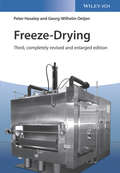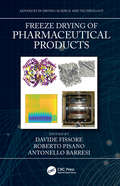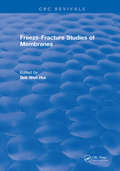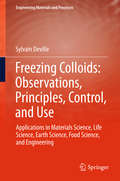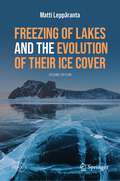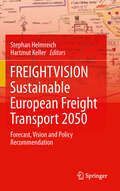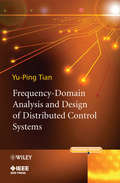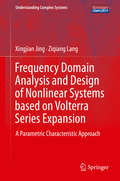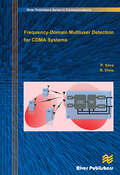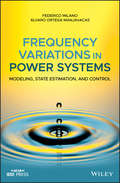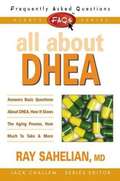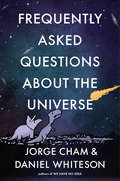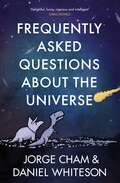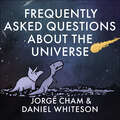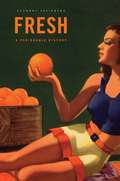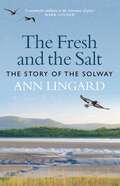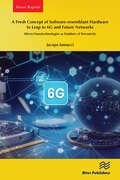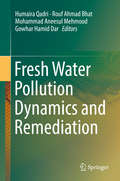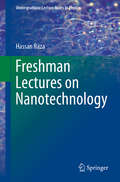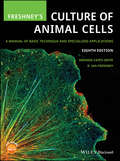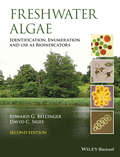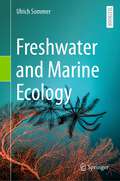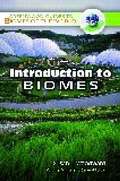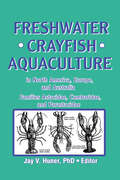- Table View
- List View
Freeze-Drying
by Peter Haseley Georg-Wilhelm OetjenThis completely updated and enlarged third edition of the classic text adopts a practical approach to describe the fundamentals of freeze-drying, backed by many explanatory examples. Following an introduction to the fundamentals, the book goes on to discuss process and plant automation as well as methods to transfer pilot plant qualifications and process data to production. An entire section is devoted to a large range of different pharmaceutical, biological, and medical products. New to this edition are chapters on antibodies, freeze-dry microscopy, TEMPRIS, microwave freeze-drying, spray freeze-drying, and PAT. Their many years of experience in freeze-drying enable the authors to supply valuable criteria for the selection of laboratory, pilot and production plants, discussing the advantages, drawbacks and limitations of different plant designs. Alongside guidelines for the evaluation and qualification of plants and processes, the author also includes a troubleshooting section.
Freeze Drying of Pharmaceutical Products (Advances in Drying Science and Technology)
by Davide Fissore Roberto Pisano Antonello BarresiFreeze Drying of Pharmaceutical Products provides an overview of the most recent and cutting-edge developments and technologies in the field, focusing on formulation developments and process monitoring and considering new technologies for process development. This book contains case studies from freeze dryer manufacturers and pharmaceutical companies for readers in industry and academia. It was contributed to by lyophilization experts to create a detailed analysis of the subject matter, organically presenting recent advancements in freeze-drying research and technology. It discusses formulation design, process optimization and control, new PAT-monitoring tools, multivariate image analysis, process scale-down and development using small-scale freeze-dryers, use of CFD for equipment design, and development of continuous processes. This book is for industry professionals, including chemical engineers and pharmaceutical scientists.
Freeze-Fracture Studies of Membranes
by Sek Wen HuiThis volume is a kind of celebration of the progress of freeze-fracture electron microscopy in recent years. Many of the authors are leaders of the advancing front. Instead of offering an instruction manual of how to perform new techniques or a review to recover what has happened in the past in respect fields, both which are abundantly available as journal articles and monographs, this volume is a collection of personal testimonies as examples of the power of the new freeze-fracture technology. Since each chapter also centres around specific biological problem, it also serves to illustrate how much the understanding of the problem has been advanced by the new freeze-fracture methodology, which is most cases is developed by the author(s) themselves. A characteristic of frontier development is that many chapters are dealing with controversial subjects. The Inclusion of these subjects in the volume represents the dynamic nature of the subject as viewed by the authors rather than the final verdicts of the subject matter.
Freezing Colloids: Observations, Principles, Control, and Use
by Sylvain DevilleThis book presents a comprehensive overview of the freezing of colloidal suspensions and explores cutting-edge research in the field. It is the first book to deal with this phenomenon from a multidisciplinary perspective, and examines the various occurrences, their technological uses, the fundamental phenomena, and the different modeling approaches. Its chapters integrate input from fields as diverse as materials science, physics, biology, mathematics, geophysics, and food science, and therefore provide an excellent point of departure for anyone interested in the topic. The main content is supplemented by a wealth of figures and illustrations to elucidate the concepts presented, and includes a final chapter providing advice for those starting out in the field. As such, the book provides an invaluable resource for materials scientists, physicists, biologists, and mathematicians, and will also benefit food engineers, civil engineers, and materials processing professionals.
Freezing of Lakes and the Evolution of Their Ice Cover (Springer Praxis Books)
by Matti LeppärantaThis book updates the first edition for the status of knowledge in the physics of lake ice and the interactions between the ice cover and the liquid water underneath. Since the first edition was written in 2013, there has been a lot of progress in the field, in particular concerning environmental questions and the impact of climate change. Life conditions in ice-covered lakes and practical matters are now brought more into the picture so that the revision also properly serves as a handbook for applications. The author has worked widely with boreal lakes, polar lakes and Central Asian lakes that provides a wide geographical spectrum.Chapter 1 gives a brief overview and presents the research fields. The second chapter contains the classification of ice-covered lakes and observation techniques, especially remote sensing. In Chapter 3, the structure and properties of lake ice are presented including optics and geochemistry. Ice growth and melting are treated in Chapter 4, while the following chapter focuses on ice mechanics with applications to traffic on ice and ice loads. Chapter 6 goes into the exotic environment of pro-glacial lakes. Chapter 7 contains the stratification and circulation of the water body beneath lake ice, Chapter 8 presents the winter ecology of freezing lakes and discusses the lake ice interface toward the society, and Chapter 9 summarizes the climate change impact on lake ice seasons. The book ends into a brief closing chapter and list of references. Research problems for student learning are listed throughout the book. Annexes are included to provide numerical data of constants and standard formulae to help practical calculations and student tasks.Lake ice closely interacts with human living conditions, but people have learnt to live with that and to utilize the ice. In the present time this is true for on-ice traffic and recreation activities. Ice fishing has become a widely enjoyed hobby, and winter sports such as skiing, skating, and ice sailing are popular activities on frozen lakes. The lake ice response to eventual climate warming would appear as a shortening of the ice season due to the increasing air temperature and also as changing of the quality of the ice seasons via changes in ice thickness and structure. The book gives the whole story of lake ice into a single volume. The second, revised edition updates the content based on recent progress in winter limnology and ice physics research and applications. The author has contributed to lake ice research since the 1980s. In particular, his topics have been lake ice structure and thermodynamics, light transfer in ice and snow, ice mechanics in large lakes, and lake ice climatology. Mathematical modeling of ice growth, drift, and decay are covered in this research.
FREIGHTVISION - Sustainable European Freight Transport 2050
by Stephan Helmreich Hartmut KellerThis book has been written on the basis of the research done between 2008 and 2010 as part of the European Commission funded FREIGHTVISION project. The "FREIGHTVISION - Freight Transport 2050 Foresight" project was funded by the Directorate General MOVE to design a long term vision for European freight transport in 2050 and to identify actions and research to progress appropriate freight transport measures in Europe. The project was carried out as a foresight process encompassing four conferences in which the project team identified and developed with the aid of more than 100 experts an action plan for securing long term freight transport in Europe. The book provides insights into the freight transport visions and Backcasts identified for 2035 and 2050, issues which need to be addressed and measures which were assessed to be part of future paths to assure an economical, environmental, and social freight transport system.
Frequency-Domain Analysis and Design of Distributed Control Systems (Wiley - IEEE)
by Yu-Ping TianThis book presents a unified frequency-domain method for the analysis of distributed control systems. The following important topics are discussed by using the proposed frequency-domain method: (1) Scalable stability criteria of networks of distributed control systems; (2) Effect of heterogeneous delays on the stability of a network of distributed control system; (3) Stability of Internet congestion control algorithms; and (4) Consensus in multi-agent systems. This book is ideal for graduate students in control, networking and robotics, as well as researchers in the fields of control theory and networking who are interested in learning and applying distributed control algorithms or frequency-domain analysis methods.
Frequency Domain Analysis and Design of Nonlinear Systems based on Volterra Series Expansion
by Xingjian Jing Ziqiang LangThis book is a systematic summary of some new advances in the area of nonlinear analysis and design in the frequency domain, focusing on the application oriented theory and methods based on the GFRF concept, which is mainly done by the author in the past 8 years. The main results are formulated uniformly with a parametric characteristic approach, which provides a convenient and novel insight into nonlinear influence on system output response in terms of characteristic parameters and thus facilitate nonlinear analysis and design in the frequency domain. The book starts with a brief introduction to the background of nonlinear analysis in the frequency domain, followed by recursive algorithms for computation of GFRFs for different parametric models, and nonlinear output frequency properties. Thereafter the parametric characteristic analysis method is introduced, which leads to the new understanding and formulation of the GFRFs, and nonlinear characteristic output spectrum (nCOS) and the nCOS based analysis and design method. Based on the parametric characteristic approach, nonlinear influence in the frequency domain can be investigated with a novel insight, i. e. , alternating series, which is followed by some application results in vibration control. Magnitude bounds of frequency response functions of nonlinear systems can also be studied with a parametric characteristic approach, which result in novel parametric convergence criteria for any given parametric nonlinear model whose input-output relationship allows a convergent Volterra series expansion. This book targets those readers who are working in the areas related to nonlinear analysis and design, nonlinear signal processing, nonlinear system identification, nonlinear vibration control, and so on. It particularly serves as a good reference for those who are studying frequency domain methods for nonlinear systems.
Frequency-Domain Multiuser Detection for CDMA Systems (River Publishers Series In Communications Ser.)
by Paulo Silva Rui DinisFuture broadband wireless communication systems are expected to be able to offer new and powerful services enabling fast transmission rates of several tens of Mbit/s. This is an ambitious challenge especially for mobile communication systems since these systems should be able to cope with severely time dispersive channels, associated to the signal multipath propagation. Moreover, these systems should have high spectral and power efficiencies, as well as high capacity and flexibility. Spread spectrum techniques, particularly coded division multiple access (CDMA) techniques allow high capacity and flexibility, continuous transmission requiring low-peak power requirements for the amplifiers, as well as some robustness against fading and time-dispersion effects associated with the multipath propagation. When employed in prefix assisted (PA) block transmission schemes combined with frequency-domain receiver implementations they become especially interesting for broadband wireless systems. In Frequency-Domain Multiuser Detection for CDMA Systems the use of PA block transmission is considered in the context of both DS (Direct Sequence) and MC (Multicarrier) CDMA schemes. The main goal is the study of frequency-domain multiuser detection techniques with iterative signal detection/decoding techniques, also in combination with estimation and cancelation of nonlinear distortion effects. The receiver structures are suitable to scenarios with high interference levels and strongly time-dispersive channels.
Frequency Variations in Power Systems: Modeling, State Estimation, and Control (Wiley - IEEE)
by Federico Milano Alvaro Ortega ManjavacasFrequency Variations in Power Systems: Modeling, State Estimation and Control presents the Frequency Divider Formula (FDF); a unique approach that defines, calculates and estimates the frequency in electrical energy systems. This authoritative book is written by two noted researchers on the topic. They define the meaning of frequency of an electrical quantity (such as voltage and current) in non-stationary conditions (for example the frequency is not equal to the nominal one) and pose the foundation of the frequency divider formula. The book describes the consequences of using a variable frequency in power system modelling and simulations, in state estimation and frequency control applications. In addition, the authors include a discussion on the applications of the frequency divider in systems where part of the generation is not based on synchronous machines, but rather on converter-interfaced energy resources, such as wind and solar power plants. This important book: Offers a review that clearly defines and shows how the Frequency Divider Formula can be applied Discusses the link between frequency and energy in power systems Presents a unified vision that accurately reveals the common thread that links modelling, control and estimation Includes information on the many implications that “local frequency variations” have on power system dynamics and control Contains several numerical examples Written for researchers, academic staff members, students, specialised consultants and professional software developers, Frequency Variations in Power Systems questions the conventional transient stability model of power system and proposes a new formulation.
Frequently Asked Questions: All About DHEA
by Ray SahelianThis book is about the potential benefits and side effects of the hormone DHEA
Frequently Asked Questions about the Universe
by Jorge Cham Daniel Whiteson"Delightful, funny, and yet rigorous and intelligent: only Jorge and Daniel can reach this exquisite balance." —Carlo Rovelli, author of Seven Brief Lessons on Physics and HelgolandYou&’ve got questions: about space, time, gravity, and the odds of meeting your older self inside a wormhole. All the answers you need are right here.As a species, we may not agree on much, but one thing brings us all together: a need to know. We all wonder, and deep down we all have the same big questions. Why can&’t I travel back in time? Where did the universe come from? What&’s inside a black hole? Can I rearrange the particles in my cat and turn it into a dog? Researcher-turned-cartoonist Jorge Cham and physics professor Daniel Whiteson are experts at explaining science in ways we can all understand, in their books and on their popular podcast, Daniel and Jorge Explain the Universe. With their signature blend of humor and oh-now-I-get-it clarity, Jorge and Daniel offer short, accessible, and lighthearted answers to some of the most common, most outrageous, and most profound questions about the universe they&’ve received. This witty, entertaining, and fully illustrated book is an essential troubleshooting guide for the perplexing aspects of reality, big and small, from the invisible particles that make up your body to the identical version of you currently reading this exact sentence in the corner of some other galaxy. If the universe came with an FAQ, this would be it.
Frequently Asked Questions About the Universe
by Daniel Whiteson Jorge ChamYou've got questions: about space, time, gravity, and the odds of meeting your older self inside a wormhole. All the answers you need are right here.As a species, we may not agree on much, but one thing brings us all together: a need to know. We all wonder, and deep down we all have the same big questions. Why can't I travel back in time? Where did the universe come from? What's inside a black hole? Can I rearrange the particles in my cat and turn it into a dog?Physics professor Daniel Whiteson and researcher-turned-cartoonist Jorge Cham are experts at explaining science in ways we can all understand, in their books and on their popular podcast, Daniel and Jorge Explain the Universe. With their signature blend of humour and oh-now-I-get-it clarity, Jorge and Daniel offer short, accessible, and lighthearted answers to some of the most common, most outrageous, and most profound questions about the universe they've been asked.This witty, entertaining, and fully illustrated book is an essential troubleshooting guide for the perplexing aspects of reality, big and small, from the invisible particles that make up your body to the identical version of you currently reading this exact sentence in the corner of some other galaxy. If the universe came with an FAQ, this would be it.
Frequently Asked Questions About the Universe
by Daniel Whiteson Jorge ChamAn eminent physicist at CERN and the cartoonist behind the hugely successful PhD Comics answer the most important, most outrageous and funniest questions about everything.You've got questions: about space, time, gravity, and the odds of meeting your older self inside a wormhole. All the answers you need are right here.As a species, we may not agree on much, but one thing brings us all together: a need to know. We all wonder, and deep down we all have the same big questions. Why can't I travel back in time? Where did the universe come from? What's inside a black hole? Can I rearrange the particles in my cat and turn it into a dog?Physics professor Daniel Whiteson and researcher-turned-cartoonist Jorge Cham are experts at explaining science in ways we can all understand, in their books and on their popular podcast, Daniel and Jorge Explain the Universe. With their signature blend of humour and oh-now-I-get-it clarity, Jorge and Daniel offer short, accessible, and lighthearted answers to some of the most common, most outrageous, and most profound questions about the universe they've been asked.This witty and entertaining audiobook is an essential troubleshooting guide for the perplexing aspects of reality, big and small, from the invisible particles that make up your body to the identical version of you currently reading this exact sentence in the corner of some other galaxy. If the universe came with an FAQ, this would be it.(P) 2021 Hodder & Stoughton Limited
Fresh: A Perishable History
by Susanne FreidbergThat rosy tomato perched on your plate in December is at the end of a great journey—not just over land and sea, but across a vast and varied cultural history. This is the territory charted in Fresh. Opening the door of an ordinary refrigerator, it tells the curious story of the quality stored inside: freshness. We want fresh foods to keep us healthy, and to connect us to nature and community. We also want them convenient, pretty, and cheap. Fresh traces our paradoxical hunger to its roots in the rise of mass consumption, when freshness seemed both proof of and an antidote to progress. Susanne Freidberg begins with refrigeration, a trend as controversial at the turn of the twentieth century as genetically modified crops are today. Consumers blamed cold storage for high prices and rotten eggs but, ultimately, aggressive marketing, advances in technology, and new ideas about health and hygiene overcame this distrust. Freidberg then takes six common foods from the refrigerator to discover what each has to say about our notions of freshness. Fruit, for instance, shows why beauty trumped taste at a surprisingly early date. In the case of fish, we see how the value of a living, quivering catch has ironically hastened the death of species. And of all supermarket staples, why has milk remained the most stubbornly local? Local livelihoods; global trade; the politics of taste, community, and environmental change: all enter into this lively, surprising, yet sobering tale about the nature and cost of our hunger for freshness.
The Fresh and the Salt: The Story of the Solway
by Ann Lingard“Beautiful, intensely visual prose, born from deep intimacy with subtle borderlands: land and sea, England and Scotland, people and environments.” —David Gange, author of The Frayed Atlantic EdgeFirths and estuaries are liminal places, where land meets sea and tides meet freshwater. Their unique ecosystems support a huge range of marine and other wildlife: human activity too is profoundly influenced by their waters and shores.The Solway Firth—the crooked finger of water that both unites and divides Scotland and England—is a beautiful yet unpredictable place and one of the least-industrialized natural large estuaries in Europe. Its history, geology and turbulent character have long affected the way its inhabitants, both human and non-human, have learnt to live along and within its ever-changing margins.“Lingard’s scientific knowledge of the area and its multitudinous inhabitants [is] delivered in riveting prose. This is deep and beautiful natural history writing.” —BBC Countryfile Magazine“Like a hungry gull, Ann Lingard explores her beloved Solway shoreline for every living detail that catches her eye. In so doing she has created a portrait of this nation-cleaving water that is as broad and deep as the estuary itself.” —Mark Cocker, author of Birds & People“A kaleidoscopic portrait of the borders of the land.” —Cumbria Life“Lingard writes vividly about this estuary . . . an excellent point of reference for locals, visitors and for those simply intrigued by this lesser-known corner of Scotland.” —Scottish Field
A Fresh Concept of Software-resemblant Hardware to Leap to 6G and Future Networks: Micro/Nanotechnologies as Enablers of Pervasivity
by Jacopo IannacciFor a decade, with the uptake of 4G, we have become accustomed to the relentless increase in data and services on the move. The deployment of 5G is advancing crucial key performance indicators (KPIs), along with quality of service (QoS). Setting the horizon to 2030 and later, 6G will take the KPIs to numbers 100–1000 times better than 5G. Yet, the actual disruption of 6G and future networks (FN) will take place following other unprecedented paths.Artificial intelligence (AI) will be exploited in a threadlike fashion, at any level of the network physical infrastructure. This will introduce, to date unknown features, like self-sustaining, self-evolution and high-resilience of small portions of the infrastructure, pioneering the concept of a network of networks. Each segment of the infrastructure will bear a high degree of independence, while working at the same time as a whole, in full orchestration with the rest of the network.Given such a scenario, this book claims that the established and currently in use paradigms for the design and development of hardware–software (HW–SW) systems, are not appropriate to address the challenges of 6G and, further ahead, of FN. In response, unprecedented design approaches are suggested, relying on a fresh reinterpretation of the standard concept of HW, with specific attention to the network edge and edge intelligence (EI).This work develops some conceptual tools that may help address the technical challenges resulting from the intricate scenario sketched above. Within the mentioned HW reconceptualization, a pivotal role is forecasted for microtechnologies and nanotechnologies, intended with a broad meaning, which embraces, among others, devices, systems (MEMS/NEMS) and materials.
Fresh Water Pollution Dynamics and Remediation
by Humaira Qadri Rouf Ahmad Bhat Mohammad Aneesul Mehmood Gowhar Hamid DarFreshwater is a finite resource and is being deteriorated directly and indirectly by anthropogenic pressures. Preserving the quality and availability of freshwater resources is becoming one of the most pressing environmental challenges on the international horizon. To ensure the preservation as well as availability of freshwater resources, there is a need to understand the ecology of the freshwater systems, pollution problems, their impacts, restoration techniques to be opted and the conservation measures. In this backdrop the present book on ‘Freshwater Pollution Dynamics and Remediation’ has been compiled. The book provides an understanding about the present state of art, pollution impacts including the changes in the environmental quality as well as the shift in the aquatic biological communities of the fragile freshwater ecosystems. Besides, the impact of deteriorating quality of the freshwater ecosystems on the animal and human health is also discussed in detail. This book provides a comprehensive account of the techniques based on updated research in biotechnology, bio-remediation, phyto-remediation and nano-bioremediation. The role of biosorpers and biofilms as a remediation tool has also been detailed. The book is a ready reference for researchers, scientists and educators who are involved in the freshwater pollution, remediation and management studies. The book editors with an expertise in diverse research fields in freshwater ecosystems have congregated the most inclusive research accounts on the freshwater pollution and remediation and thus developed a repository of diverse knowledge on the subject
Freshman Lectures on Nanotechnology (Undergraduate Lecture Notes in Physics)
by Hassan RazaNanotechnology is the art, science, and engineering of designing materials, devices, and systems at the nanoscale from bottom-up and/or top-down approaches. The material properties at the nanoscale are governed by quantum mechanics, and hence are drastically different than those at the macro/micro scale. It is thus no surprise, that nanotechnology has led to a scientific and technological revolution. This book provides a gentle introduction to the field of nanotechnology for first-year undergraduate students. It not only covers the fundamental scientific concepts in a tutorial fashion, but also provides an overview of applications in nanoelectronics, spintronics, nanophotonics, nanofabrication and nanocharacterization. End of chapter research assignments focus on nanomanufacturing, computing and communication, renewable energy, defense applications, food processing and agriculture, automobile and aerospace technology, nanobiotechnology and bionanotechnology, industrial and consumer applications. Finally, the topics related to safety, health, and societal impact of nanotechnology are discussed.
Freshney's Culture of Animal Cells: A Manual of Basic Technique and Specialized Applications
by Amanda Capes-Davis R. Ian FreshneyThe new edition of the leading text on the basic methodology of cell culture, fully updated to reflect new applications including iPSCs, CRISPR, and organ-on-chip technologies Freshney's Culture of Animal Cells is the most comprehensive and up-to-date resource on the principles, techniques, equipment, and applications in the field of cell and tissue culture.Explaining both how to do tissue culture and why a technique is done in a particular way, this classic text covers the biology of cultured cells, how to select media and substrates, regulatory requirements, laboratory protocols, aseptic technique, experimental manipulation of animal cells, and much more. The eighth edition contains extensively revised material that reflects the latest techniques and emerging applications in cell culture, such as the use of CRISPR/Cas9 for gene editing and the adoption of chemically defined conditions for stem cell culture. A brand-new chapter examines the origin and evolution of cell lines, joined by a dedicated chapter on irreproducible research, its causes, and the importance of reproducibility and good cell culture practice. Throughout the book, updated chapters and protocols cover topics including live-cell imaging, 3D culture, scale-up and automation, microfluidics, high-throughput screening, and toxicity testing. This landmark text: Provides comprehensive single-volume coverage of basic skills and protocols, specialized techniques and applications, and new and emerging developments in the field. Covers every essential area of animal cell culture, including lab design, disaster and contingency planning, safety, bioethics, media preparation, primary culture, mycoplasma and authentication testing, cell line characterization and cryopreservation, training, and troubleshooting. Features a wealth of new content including protocols for gene delivery, iPSC generation and culture, and tumor spheroid formation. Includes an updated and expanded companion website containing figures, artwork, and supplementary protocols to download and print. The eighth edition of Freshney’s Culture of Animal Cells is an indispensable volume for anyone involved in the field, including undergraduate and graduate students, clinical and biopharmaceutical researchers, bioengineers, academic research scientists, and managers, technicians, and trainees working in cell biology, molecular biology, and genetics laboratories.
Freshwater Algae
by David C. Sigee Edward G. BellingerFreshwater Algae: Identification and Use as Bioindicators provides a comprehensive guide to temperate freshwater algae, with additional information on key species in relation to environmental characteristics and implications for aquatic management. The book uniquely combines practical material on techniques and water quality management with basic algal taxonomy and the role of algae as bioindicators. Freshwater Algae: Identification and Use as Bioindicators is divided into two parts. Part I describes techniques for the sampling, measuring and observation of algae and then looks at the role of algae as bioindicators and the implications for aquatic management. Part II provides the identification of major genera and 250 important species. Well illustrated with numerous original illustrations and photographs, this reference work is essential reading for all practitioners and researchers concerned with assessing and managing the aquatic environment.
The Freshwater Alphabet Book (Jerry Pallotta's Alphabet Books)
by Jerry PallottaCome take a swim with freshwater creatures from around the world! Meet a fish that has no eyes and one that has four of them. Get to know an eel that carries enough electricity to light up a light bulb and a glacier-dwelling worm with blood that works like antifreeze.Jerry Pallotta has done it again! The acclaimed alphabet-book author has joined forces with illustrator David Biedrzycki to create an exquisite and informative introduction to freshwater dwellers.
Freshwater and Marine Ecology
by Ulrich SommerFreshwater and Marine Ecology is an introduction to the field of aquatic ecology, integrating the conceptually and methodologically widely overlapping fields of limnology and biological oceanography. It is structured like most textbooks of general ecology, leading from more elemental entities (individuals having to cope with their environment) to increasingly overarching entities, from populations over communities and ecosystems to the biogeochemistry of the entire planet and, finally, an overview over the major human impacts on the aquatic components of the earth system. The book provides examples for all major theoretical concepts of general ecology while the usual ecology textbooks have a strong terrestrial bias and rely only on few aquatic examples. This book takes the contrasting approach, motivated by the fact the fact that life originated from aquatic systems and that surface waters cover more than 70% of the Earth’s surface. The choice of studies used as examplesin Freshwater and Marine Ecology provides a balanced mix of freshwater and marine studies, of field observations, experimental and modeling studies. The readers are confronted with very recent work leading to the forefront of contemporaneous research but also with classic studies which laid the foundations of theory development in the field. Freshwater and Marine Ecology is a comprehensive text ideally serving for undergraduate courses in biological oceanography, limnology, and ecology, but also for advanced students, teachers and scientists who had limited exposure to aquatic sciences and/or ecology during their studies.
Freshwater Aquatic Biomes (Greenwood Guides to Biomes of the World)
by Richard A. RothFor middle and high school students and undergraduates, Woodward, editor of the biomes series and former professor of biogeography and physical geography at Radford U., presents an introduction to biomes. She discusses the concept of the biome and other geographic trends exhibited by life, including taxonomic and evolutionary patterns, related ecological concepts such as ecosystems and soils, and environmental factors that affect the nature of terrestrial and aquatic biomes at the global scale. Use of scientific terminology is minimized. Annotation ©2009 Book News, Inc., Portland, OR (booknews.com)
Freshwater Crayfish Aquaculture in North America, Europe, and Australia: Families Astacidae, Cambaridae, and Parastacidae
by Jay HunerFreshwater Crayfish Aquaculture in North America, Europe, and Australia is the first text to summarize the methods of culture for the eight most important crayfish species in the world. Methods developed to culture crayfishes around the world differ significantly, and this book enables readers to develop workable strategies for cultivating different crayfish species in specific environments. Huner and associate authors cover the following topics in detail: methods of crayfish culture crayfish diseases crayfish processing economics of crayfish cultureEach of the the three major crayfish industries are well-represented in this new book and special attention is given to the specific needs and accomplishments of each area, which is beneficial to producers in other countries. For example, while hatching technology has been important in Australia and Europe, it hasn?t yet been applied to any degree in North America. At the same time, North America has developed a major crayfish processing industry. Disease problems have resulted in more emphasis on that subject in Europe and yet it is vital to all involved in crayfish aquaculture. Businessmen, farmers, scientists, laymen, or students need to be exposed to the methods and problems associated with crayfish production in different parts of the world if they are to be successful in any crayfish project, whether it be research- or profit-oriented. Freshwater Crayfish Aquaculture in North America, Europe, and Australia is intended to provide all readers with one source of information on the subject of freshwater crayfish aquaculture.Professional staff, advanced students, and extension personnel will find the entire text beneficial. Those in corporate organizations and the agriculture field, especially decisionmakersin operations, will find the methods, markets, and financial considerations in this book a helpful guide.
